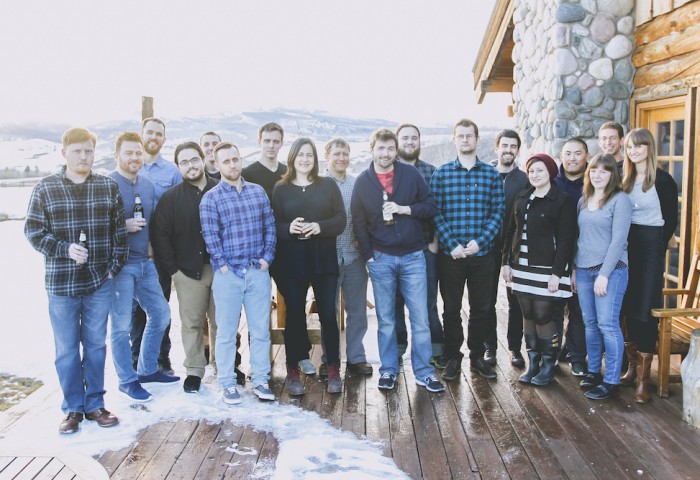For productivity company Saent, location independence is more than just a convenience — it also reinforces the company’s values. Josh Catone, who is responsible for press, content, and partnerships at Saent, told us why.
How many employees and contractors do you have? (range is OK).
Our core team is 3 full-time people and 2 part-time people. We also have a few dozen contractors working on software development, hardware production, and design (marketing and user interface). Our employees and contractors are spread across the U.S., Europe and Asia, in four or five different time zones.
Please tell us about the importance of location independence at your company.
Location independence is more than just a convenience for us. It’s also a forcing function for our values as a company. Being distributed means we have to place greater stock in trusting each other, being honest and transparent, finding balance, focusing, and valuing deep thought. Each of those things become more important in a distributed environment where you can’t always just get in a room and hash out misunderstandings or differences, and they also all happen to be guiding principles for Saent as a company.
Did you start with the intention of having a distributed or nomadic team? If not, when did you decide to support people working remotely?
It wasn’t a conscious decision from the beginning, other than our co-founders Tim Metz and Russell Haines each having a desire to avoid traditional office culture / management structures and the bureaucracy and overhead that comes along with that. Saent as a remote company pretty quickly resolved itself organically, though. From the beginning Tim was working from home and Russell from his office in Beijing, China, our software was being developed in Ho Chi Minh City, Vietnam, and then I joined the team from halfway around the world in Providence, RI, USA.
What’s the upside that comes with not having a central location or office?
It saves us money, of course — office space isn’t cheap! But it also allows us to hire the best person for the job regardless of where that person is located. Whether that means Beijing or Berlin, Los Angeles or Providence, Hong Kong or Amsterdam (yes, we’ve worked with people in each of those places!). In short: it means our talent pool is limitless, which is a huge competitive advantage.
Another fringe benefit is that it means we have people awake and working on Saent basically 24/7. So if something implodes or a customer has an urgent issue, we’re better prepared — even as a very small team — to deal with the issue quickly.
What % of your company regularly works remotely?
100% of our core team works remotely, and many of our contractors do as well. (We even contract some of our design work to an agency that is itself a fully distributed company!)
Any advice or best practices for supporting the work styles of your teammates from a distance?
Communication is the big one. And because we’re so spread out, written communication specifically is a skill that everyone needs to develop. Though we try to meet with each other live via video conference or voice calls at least once per week, the vast majority of our communication happens asynchronously through tools like Slack, email, Google Docs, and BlogIn. It’s important to be able to clearly explain yourself so you don’t end up just getting confused questions back from a colleague 12 hours later. There are times, of course, when written communication just doesn’t cut it, and it is easier to explain something out loud. For that, we’ve found WeChat’s voice message feature, which allows us to have asynchronous voice chats in 60 seconds snippets, to be very helpful.
The other vital piece of our success is transparency. Successful remote teams are ones that empower people to make decisions and operate autonomously. Everyone on the core team has access to our entire Google Drive, including our balance sheet and financial projections, and all our Slack channels are open for anyone to join and follow along with progress on any specific initiative. By doing everything out in the open, we can ensure that team members usually have all the information they need to make a decision quickly, even if they happen to be the only one awake or available.
Both of those practices are apparent in our daily huddle — a channel on Slack in which each team member reports every day on what they’re doing today, key performance indicators for their goals, and whether or not they’re stuck on anything. Team members also use that space to reaffirm their weekly and monthly goals. It’s a good way for everyone to stay in sync, to quickly recognize if a team member is getting off track, or to jump in and help when someone is stuck.
What types of places do your teammates choose to work from when remote?
The beauty of remote work is the flexibility it offers. We don’t have to pigeon hole anyone to a specific working place, style, or even time. There’s no, “You work here, at that desk, during these times.” So everyone can work according to whatever suits their life best. Though Saent is a small team, we already represent a pretty diverse set of work styles. Some work mainly in the early mornings, while others work in the evenings. Some work from home, others from coffee shops or co-working spaces. (I tend to work mainly from home and coffee shops these days.) But it really doesn’t matter — however you work best is really how you should work. And of course, everyone at Saent uses Saent to block out the noise and find their deep focus no matter where or when they choose to work.
What qualities do you look for when hiring for a distributed team?
Working remotely requires a certain set of skills or personality traits. The most important are probably communication, self discipline, and confidence. Good remote team members have superior communication skills, and, importantly, know how to communicate in whatever method the team uses (for us that’s mostly asynchronously and written, so we actually conduct interviews with prospective hires over Slack, sometimes over the course of days, to get a good feel for how they’ll fit into our work style). They also have the discipline to stay on task and get work done even when no one is telling them to do it, and they have the confidence to just try something without “permission” or validation (since that isn’t always easy to come by if your colleagues are thousands of miles away). The latter is something that has to be baked into the culture. At Saent we try to make sure everyone feels empowered in their role to own the things they’re responsible for and has the tools and information to make decisions on their own when necessary.
You’ve built great products that help the distributed workforce at large. Why did you choose to do that?
We think that, collectively, our attention spans are being stretched to the breaking point by always-on digital technologies, which means it’s harder than ever to focus and get work done. This is a huge issue for everyone, but for remote workers especially, who really have to be disciplined to work autonomously and with minimal oversight. Our products create the ideal conditions for doing amazing work, while offering positive behavior change recommendations — such as taking adequate breaks away from the screen — that lead to healthier and more productive work habits.
This is only going to get more important as digital companies whose business models are based around user attention get better at sucking us in.
What are your thoughts on Workfrom’s role in the way work is getting done—now and in the future?
Remote work has a ton of benefits, but it’s not all puppies and rainbows. As with anything, there are tradeoffs, and one of the big ones for people working outside of an office setting is loneliness. One of the main benefits of a traditional office setting is the real-world community that develops. Though it doesn’t always contribute to the bottom line in a directly measurable way, I think most people do crave some level of human contact. Those times in between work — we’re not robots that can work 24/7 without breaks, after all — should sometimes be filled with human interaction. Talking to other people, bouncing ideas around, commiserating, or just goofing off, these are things that I think we all need to some degree and it can be harder to come by when you’re not in an office surrounded by other people.
I think Workfrom can play a role in building that community and fostering those connections for remote workers. Whether that’s by connecting them to popular coffee shops or work spaces or by creating virtual communities online, it’s important to be able to fill those non-work gaps with a little humanity (especially for those of us whose work time revolves around interacting with screens, algorithms, or applications — that is, probably most remote workers these days).
Is there anything else you’d like to share? Our goal is to gain insight into your path as a distributed team and help others understand what it looks like to be successful in spite of the challenges often faced.
One thing we’ve learned is that it is helpful to demonstrate your culture, style, and atmosphere from day one — even before day one. For example, earlier this year we hired a librarian to organize our institutional knowledge, support our users, and generally build community around the philosophies and science that drive Saent. As with all of our roles, this one is fully remote, so we knew we needed to find someone who fit well with how we worked. I mentioned this earlier, but we decided to do our hiring almost completely asynchronously. Because of the huge time zone differences at Saent, we don’t do too much ‘live’ communication (voice calls or video chat, or in person meetings). Most of what we do is via Slack, email, and Google docs.
So we employed those very tools in our interview process. We started with a back and forth over email, then moved a few top applicants into private Slack rooms for a week long, asynchronous “interview,” and then had phone chats with our final candidates. We culminated the search by having our top two prospective team members complete a project that involved creating a shared document. The process took a bit longer than a “normal” interview usually does, and dragged a bit at times, but the results were excellent. We ended up finding someone (team member Maggie Hughes) who was both eminently qualified and a fantastic fit for the team. We’d already gotten to see how she would react to working in the exact style that we do every day, and that was a huge win for us.



Responses